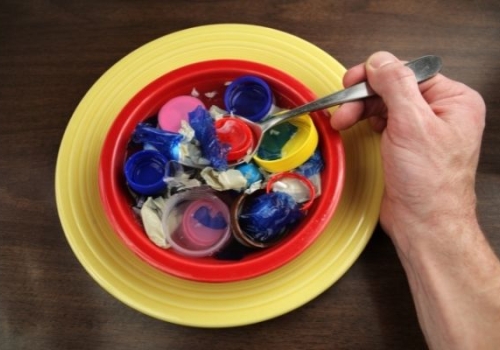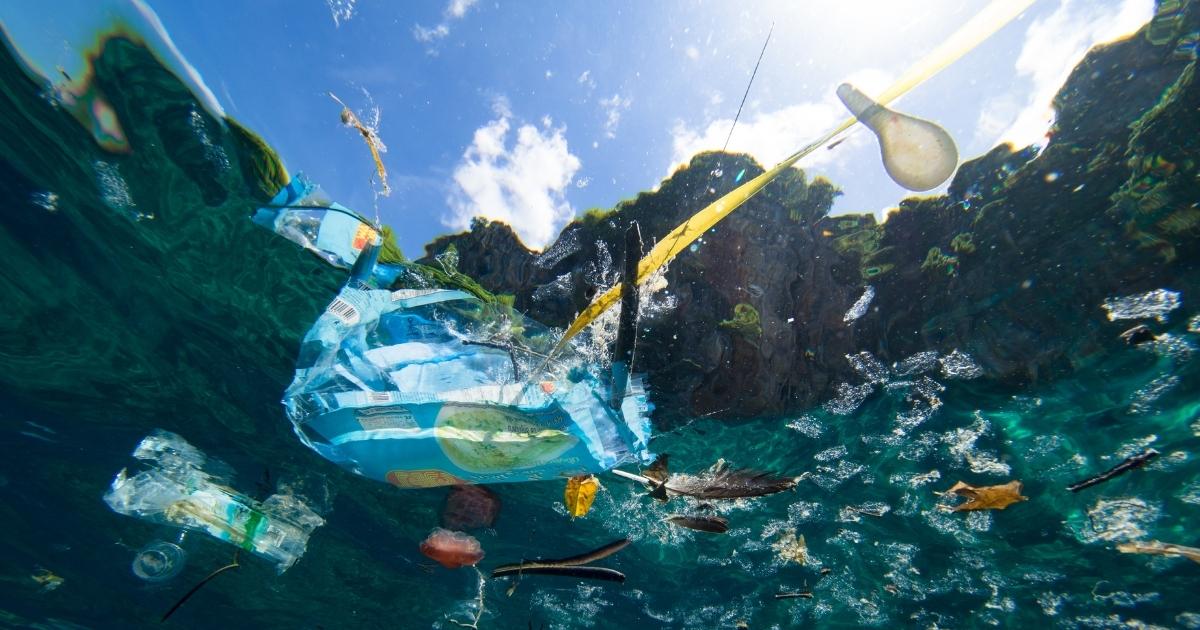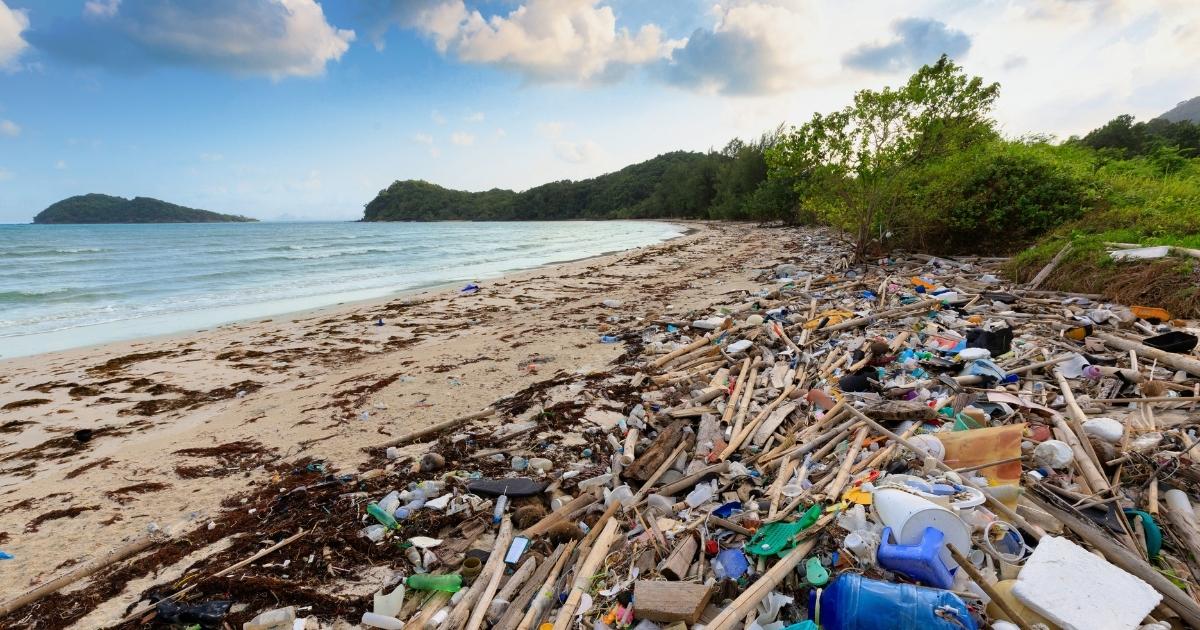Plastic Soup: Yachting's Fight Against Plastic Pollution

In my last two articles for OnboardOnline I referred to the three main threats to environmental sustainability, and the fact that they are all inexorably linked to the conservation of our oceans and waterways. They are climate change, loss of biodiversity and plastic pollution.
I also mentioned that my personal sustainability ‘light bulb moment’ was triggered when I came across an ugly slick of floating plastic debris whilst boating in the Mediterranean back in 2008. Since then, the whole subject of plastic pollution in our environment has become much higher in the public awareness, and scientific research into how microplastics are infiltrating every part of our lives has been gathering pace across the world.
In 2019, and again in October last year, I attended the ‘Plastic Health Summit’ held in Amsterdam, an all-day event organised by the Plastic Soup Foundation (PSF). At both the summits I felt shocked and motivated in equal measures by the presentations. The events were extremely well organised, with nine hours of solid scientific evidence presented by academic researchers and supported by testimonies from some knowledgeable and committed advocates and activists. These are people who are not only helping to bring the facts about plastic pollution to the attention of the public and the authorities, but also many of them are very actively doing something about it.
I have become a passionate supporter of PSF over the last few years. From humble beginnings as a small grassroots organisation in 2011, they have now become one of the undisputed global leaders in the fight against the plastic pollution, and they deserve all the financial donations they can get to help them along the way.
Its founder and director Maria Westerbos says: “Scientists warn that we have only nine years left to turn the tide on plastic pollution and prevent the damage to our ecosystems and human health from becoming irreparable. And in the meantime, the industry is only speeding up the production of disposable plastic! That is why we are focusing our plans on the year 2030, the point of irreversible environmental damage. There is hope, and we are going full steam ahead in the remainder of this decade.”
Plastic, plastic everywhere
How much plastic is in the oceans and in the environment generally? The media has been full of statistics in answer to that question during the last couple of years, and I’m sure almost everyone with any interest in ocean and environmental conservation has come across them.

They come from many sources, and we have only been aware of the ‘plastic soup’ phenomenon for about 25 years, even though plastic production has been exponentially increasing for over 70. Of course, 100% accuracy cannot be guaranteed with answers trickling in from hundreds of scientists around the world, all trying to get a handle on both the extent and the consequences of the problem.
However, Plastic Soup Foundation have put a lot of effort into publishing an overview based on a selection of data which they consider to be the most reliable from the plethora of scientific research on the subject. I cannot possibly cover it all in this article, but here are some of the key points that serve to illustrate the magnitude of the plastic pollution challenge that the world is facing.
-
In 1950 (coincidentally the year I was born), there was 2 million tons of plastic produced. By 2019 this had increased to 368 million tons per year. This phenomenal plastic production growth has happened in my lifetime!
-
56% of that total has been produced since the year 2000, and the annual volume of plastic output is on course to reach 600 million tons by 2025.
-
Around 40% of that is used for packaging, with construction and automotive industries accounting for another 30%. This means the most significant environmental benefit can be achieved by tackling the totally unjustified overuse of plastic packaging.
-
A staggering total in the region of 10 billion tons of plastic has been produced since 1950, and 40% of all plastic product is thrown away within one month.
-
Something like 25% of it is still in use, and only around 600 million tons (6%) has been recycled along the way.
-
Year after year, we saddle the world with about 300 million tons of plastic waste.
-
The average European citizen adds 33 kilos of plastic to the mountain of waste annually. The USA is said to be the largest plastic polluter, churning out 130 kilos per capita and generating an estimated 42% of the world total.
-
As most people know by now, Coca-Cola is consistently recorded as producing the highest amount of product that ends up in the environment. They are followed in the ‘top ten’ by Pepsico and several other consumer brands such as Nestle, Unilever, Mars and Procter & Gamble.

What is ‘plastic soup’ and where does the term come from?
Previous research circa 2017 indicated that 90% of all plastic in the oceans emanated from 10 major rivers, mainly in Asia and Africa. That evidence was overturned in later studies, which suggested that something like 80% of plastic pollution is contributed to by as many as 1000 rivers, many of them smaller ones which flow through heavily populated areas. For example, the River Pasig, which flows through the city of Manila in the Philippines, was found to deliver the most plastic into the sea.
A further study of global plastic pollution output into oceans by country revealed that the Philippines is in fact the largest polluter, sending 356,000 metric tons of plastic waste per year into the surrounding oceans. The next largest ocean plastic emitter is India, followed by Malaysia and China, who are bombarding the seas with around 126,000, 73,000 and 71,000 tons respectively.
What is ‘plastic soup’ made up of?
All of us, especially those who spend much of their time afloat, are familiar with the depressing sight of plastic bags, bottles, bottle tops etc. on the surface of the water, but this is only the ‘tip of the iceberg’ so to speak. It is now well documented that plastic never degrades, but instead fragments into ever smaller pieces until it cannot be seen with the naked eye. Only 0.5% of the plastic in the ocean floats on the surface of the water, the rest drifts deeper in the water column or lies on the seabed. Cleaning up the water surface only solves a small percentage of the problem.
As such, the term ‘microplastics’ has come to the fore over the last few years and is now the most worrying and highly researched aspect of the plastic pollution challenge which threatens the ocean environment and aquatic life as well as, quite likely, the health of humanity according to latest scientific laboratory studies on how tiny particles of plastic are getting into the cells and tissues of our bodies.

PSF has been at the forefront of researching and documenting various sources of microplastic as they don’t all come from fragmentation of larger pieces and are often from sources which we might not even be aware of. For instance, they can come from the degradation of car tyres, the wearing and washing of synthetic clothing, rinsing off cosmetics, face creams, facial scrubs, shampoos etc. And quite disgracefully, the ‘spilling’ (or dumping) of nurdles, which are small plastic granules resulting from the plastics production industry.
With over 200 types of plastic and very little regulation on the substances that can be used in them, the scientific community has a huge task in the coming years to deliver conclusive evidence on the health implications. The PSF team are convinced this will be the turning point which will eventually force legislators to ‘turn off the tap’ on plastic production, as it did with asbestos several decades ago. The main difference is that the investigations must cover hundreds of materials, whereas asbestos was only one or two types of composition.
How is the 'plastic soup' distributed in the world’s oceans?
In 2019, PSF compiled a very detailed overview which contains answers to this question. Again, there is too much information to repeat all of it here, but let’s discuss some of the key points.
Firstly, the plastic objects and particles in the oceans are graded according to size in four categories. The largest is identified as ‘macroplastic’ (typically a 5 litre container) and the smallest as ‘small microplastics’(a tiny fragment between 0.33 and 1.0mm in size). In between there is ‘mesoplastic’ (typically a drinks bottle), and ‘large microplastic’ (a fragment between 1.01 and 4.75 mm).
These categories are then applied to six of the world’s major marine areas identified by their size and counted in billions of pieces per zone.
Not surprisingly the North Pacific has by far the largest concentration of plastic pollution, as has been well documented for many years now. This is broken down into 1990 billion pieces in total consisting of 3 billion macro, 132 billion meso, 1160 billion large micro, and 688 billion small micro.
At second and third place in this highly dubious league table, there is the Indian Ocean with 1300 billion pieces, and the North Atlantic with 930 billion pieces.
Is plastic pollution contributing to climate change?
In a word, yes! But maybe in some ways that we might not imagine.
The most obvious reason is because plastics are made from fossil fuels. Based on the current trajectory, the emissions from plastic production could contribute between 10 and 13% of the maximum target required to keep global warming within one and a half degrees (max 570 billion tons of C02 by 2050 - at least 56 billion tons from plastic). Then there are the emissions from incineration and recycling of waste plastics, which will add even more C02 to the total.
Coming back to microplastics in the oceans and in the atmosphere, there is now serious scientific research being conducted into how their presence in ice caps, and generally floating in the air (reflecting light and heat) may be contributing to acceleration of the warming effect on the planet. This could be particularly relevant if the airborne concentrations over cities continue to increase at the present rates.

Making a change and focusing on the positives
As Maria Westerbos from PSF has said: there is hope”, and I really want to round off this article by looking at some of the reasons why we should all believe in that.
Firstly, every individual can do something to help, and I know that many of us are doing so. There are thousands of organisations and individuals around the world who are doing great work in the name of environmental sustainability, including the fight against plastic pollution. These include locally organised beach clean ups and awareness campaigns, projects such as the Ocean CleanUp (and its Interceptor River collection system), and the Great Bubble Barrier, a Dutch innovation which prevents plastic debris from leaving the mouth of rivers with an air stream curtain.
In another example, a group of young people in Indonesia are building dams themselves to stop the flow of debris in local rivers, then manually collecting and recycling the plastic.
In the Balearic Islands, a young enthusiastic group called CleanWave has installed filtered drinking water dispensers all over the island of Mallorca and made a range of reusable water bottles available so that tourists and locals don’t have to buy bottled water in single use plastic bottles.
Another local group in Mallorca called Clean Boating is providing boaters with nets and buckets and encourages them to look for floating plastic debris whenever they are underway in the harbours or around the coast of the island. They have made facilities available to ‘land the catch’ and are now exploring ways to circularise the recovered plastic into a material that can be reused in the boating industry.
Plastic pollution - personal quick wins
The above is just a few of the many inspiring actions which give me, personally, a reason to remain positive. I have also been influenced by some of the well-researched information from PSF. For instance, my family has switched some of their cosmetic products such as face creams due to the comprehensive information provided in its ‘Beat the Microbead’ campaign, which clearly identifies hundreds of products that contain unnecessary microplastics.
In 2019, I was motivated by a presentation at the Plastic Health Summit which pointed out how easy and affordable it is to fit a microfibre filter to the outlet of your washing machine. Scientists have now estimated that 35% of microplastic pollution in the oceans comes from textiles. Every day, 300 million microfibres are released into the Hudson River and the Atlantic Ocean. In California alone it is estimated that 4000 metric tons or 13.3 quadrillion fibres were released into the environment in 2019.
For less than 10 euros a month, the Planet Care microfibre washing machine filter comes complete with a filter exchange service. The used filters are regularly returned and the trapped captured responsibly recycled. Since fitting one of these units to our washing machine, I have been amazed every time I change the filter (after 20 wash cycles). There is always a significant amount of microfibre trapped inside, and I realise that it would otherwise escape into the natural environment via the public sewage system.

Science is working on plastic pollution
Quite obviously, industry in general is highly aware of this ever-growing plastic disaster, and more and more companies with sustainability strategies are actively looking for solutions.
As an example, my interest in the subject has been picked up by the Google algorithms, and consequently I have had no less than 36 articles landing in my browser feed in the last few weeks with scientific study reports on all kinds of plastic developments. So, I’m sure that I’m not the only one who gets motivated and informed!
Apparently one-fifth of companies that make or use plastic packaging have committed to a pledge called the New Plastics Economy Global Commitment, created by the Ellen MacArthur Foundation and the UN Environment Programme. Signatories promise to increase plastics recycling as part of a broader commitment to circular-economy principles, which aim to achieve continuous use of resources and eliminate waste.
Many universities and scientific institutions are busy developing new ways to produce packaging and wrapping materials that are easier to recycle or will decompose without fragmenting into harmful microfibres.
One recent report reveals the discovery of naturally occurring enzymes which can be commonly found in the environment and tweaked to become ‘plastic eating bugs.’ Using enzymes to rapidly break down plastics into their building blocks would enable new products to be made from old ones, cutting the need for virgin plastic production. The new research provides many new enzymes to be investigated and adapted for industrial use.
Another report explains how a university in the Netherlands has successfully developed a technique for breaking down the monomer links in PLA, a plastic commonly used for packaging films, food containers and disposable cutlery. As a result of weakening the links, the plastic was found to decompose completely in seawater in a very short time compared to the original PLA material, which can remain unchanged even after three years in the ocean.
These are just a couple of examples of what chemists in academia and industry are working on in order to find more environmentally acceptable ways to deconstruct and dispose of plastics. The accumulation of plastic waste in the world has now reached gargantuan levels, so decisive action from companies and governments really can’t come soon enough!
As I said, ‘plastic soup’ is only two words, but they have prompted me to write over 2500 of them for this article. It is indeed an endless subject these days, so I could have written a whole lot more, but I do hope it has been both informative and inspiring.

Post your comment
You cannot post comments until you have logged in.
Login to post a commentComments
No one has commented on this page yet.
RSS feed for comments on this page | RSS feed for all comments